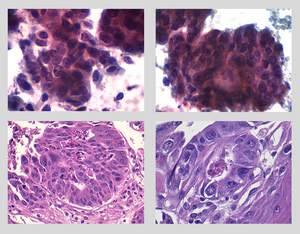SUFFERN, NY--(Marketwired - Oct 21, 2014) - CDx Diagnostics announced today that the WATS3D biopsy markedly increased detection of esophageal precancer in a new study of 1655 patients. Adding WATS3D to standard forceps biopsy testing of the esophagus produced an added yield of more than 100% for both Barrett's esophagus and dysplasia. The results are being presented at the American College of Gastroenterology (ACG) Annual Scientific Meeting and Postgraduate Course, taking place from October 17-22, 2014 in Philadelphia.
The WATS3D biopsy collects a wide area, disaggregated tissue specimen of the entire thickness of the suspect epithelium. This unique tissue specimen is then subjected to specialized, computer-assisted 3-dimensional analysis to pinpoint potentially abnormal cells for presentation to a pathologist.
The study included 19 gastroenterologists from both academic institutions and community practices and all samples were sent to a central laboratory for analysis. Forceps biopsy alone identified Barrett's esophagus in 203 cases (12%) and dysplasia in 9 cases (0.54%). Adjunctive use of WATS3D identified an additional 223 cases of Barrett's esophagus, increasing the yield to 25.7%. WATS3D also detected another 12 cases of dysplasia, increasing the yield to 1.26%. These data demonstrate added yields of 110% for Barrett's esophagus and 133% for dysplasia with WATS3D.
"Forceps biopsy testing of the esophagus remains central to the diagnosis of Barrett's esophagus and dysplasia, but we know that current biopsy protocols have inherent limitations that can leave significant areas of the esophagus at risk unsampled," said Vivek Kaul, MD, FACG, Chief of Gastroenterology at the University of Rochester Medical Center and study co-author. "These results, which are highly consistent with earlier studies performed in community-based gastroenterology practices, demonstrate that WATS3D is a powerful complementary tool to forceps biopsy and can improve patient care."
A previous study1 in community practices demonstrated that adding WATS3D to forceps biopsy increased Barrett's esophagus detection in all patients from 15% to 25% and dysplasia from 0.68% to 1.12%, for adjunctive yields of 68% and 65%, respectively.
Study co-author Michael Smith, MD, MBA, Medical Director of the Esophageal Program and Assistant Professor of Medicine at Temple University School of Medicine, added, "Esophageal adenocarcinoma is one of the most devastating forms of cancer and its incidence has grown rapidly over the past decades, in the setting of America's epidemic of obesity and GERD. The introduction of new therapeutic strategies to treat its precursor condition, Barrett's esophagus, has led to a paradigm shift in how gastroenterologists are confronting the disease. WATS3D can and will pay a vital role by improving our ability to identify higher risk patients earlier in the disease process, allowing us to intervene before cancer takes hold."
About the WATS3D Biopsy
CDx Diagnostics' WATS3D biopsy addresses the sampling error inherent in random forceps biopsy testing of the esophagus. In just a few minutes, gastroenterologists can easily obtain a wide area, full-thickness transepithelial tissue sample for computer-assisted 3D laboratory analysis. In clinical trials, adjunctive use of CDx Diagnostics' WATS3D biopsy significantly increased the detection rate of both Barrett's esophagus and esophageal dysplasia. The high sensitivity of WATS3D is due to the large tissue area sampled, and the proprietary 3-Dimensionial computer imaging system that is based on an algorithm developed as part of the U.S. Strategic Defense Initiative missile defense program. To learn more about WATS3D, visit www.WATS3D.com.
1 Gross et al. Esophageal Brush Biopsy With Computer-Assisted Tissue Analysis Increases Detection of Barrett's Esophagus and Dysplasia in a Multi-Site Community-Based Setting. Presented at Digestive Disease Week; May 2-6, 2014. Chicago. Abstract 371.
Contact Information:
Contact:
Chantal Beaudry or Christopher Frates for CDx Diagnostics
cbeaudry@lazarpartners.com
cmfrates@lazarpartners.com
212-867-1762
